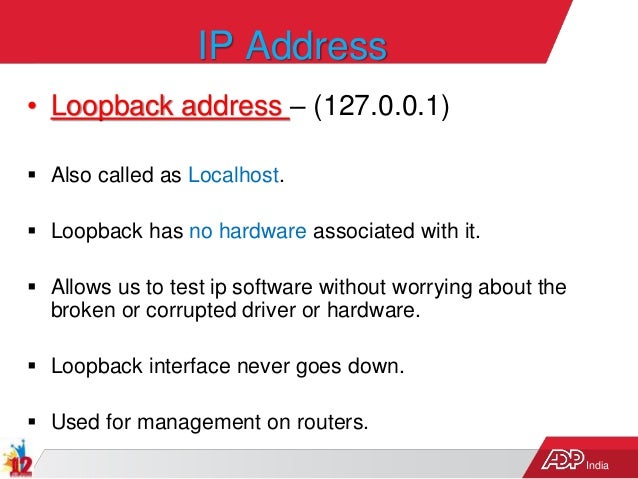Loopback Address
An address that sends outgoing signals back to the same computer for testing. In a TCP/IP network, the loopback IP address is 127.0.0.1, and pinging this address will always return a reply unless. IPv4 network standards reserve the entire address block 127.0.0.0/8 (more than 16 million addresses) for loopback purposes. That means any packet sent to any of those addresses is looped back. The address 127.0.0.1 is the standard address for IPv4 loopback traffic; the rest are not supported. Picture instruments sort n rename pro 2 0 8. Public Sub PrintLoopbackAddress ' Gets the IP loopback address and converts it to a string. Dim IpAddressString As String = IPAddress.Loopback.ToString Console.WriteLine(('Loopback IP address: ' + IpAddressString)) End Sub Remarks. The Loopback field is equivalent to 127.0.0.1 in dotted-quad notation. Address: 14900 Landmark Blvd, Suite 240 Dallas, TX 75254. Client Support: 877-858-0212 support@loopbackanalytics.com Available Weekdays from 7am – 8pm Central. Sales & Marketing: 972-480-3271 sales@loopbackanalytics.com.
A loopback address is a special IP address, 127.0.0.1,reserved by InterNIC for use in testing network cards. This IPaddress corresponds to the software loopback interface of the networkcard, which does not have hardware associated with it, and does notrequire a physical connection to a network. The loopback addressallows for a reliable method of testing the functionality of anEthernet card and its drivers and software without a physical network.It also allows information technology professionals to test IPsoftware without worrying about broken or corrupted drivers orhardware.
To test a network card using the loopback address, you can use theTCP/IP utility Ping. The best way to do this is with thePing utility that comes with most operating systems. This is a simplecommand-line utility that will try to communicate to an IP address.
To run Ping, first follow the appropriate instructions below foryour operating system:

- Windows XP: Click Start and selectPrograms or All Programs, then Accessories,then Command Prompt.
- Windows 2000: Click Start and selectPrograms, then Accessories, then CommandPrompt.
- Windows NT 4.0: Click Start and selectCommand Prompt.
- Windows 95, 98, and Me: Click Start andselect Programs, then MS-DOS Prompt.
- Unix and Linux: Open a shell prompt.
- Mac OS X: Open the Terminal.
- Mac OS: Ping wasn't available as part of the OSin Mac OS 9 and earlier. For information on three utilities you can useinstead, see ARCHIVED: In Mac OS, how can I check to see if a computer is on the network?
Once you are at a command prompt, enter the following:
If the command is successful, the Ping utility will return resultssimilar to the following. The exact information returned will varydepending on your operating system:
This indicates that the network card and drivers are functioningproperly. If the Ping utility is not able to get a return on thenetwork card, this may indicate either a driver problem, or a physicalproblem with the card. Yemuzip 2 4 6.
Local Broadcast Address:
Local Broadcast Address is used to communicate with all the devices on a local network. It is represented by 255.255.255.255 or 11111111.11111111.11111111.11111111 in binary.
A broadcast address is used by hosts to request IP addresses from the DHCP(Dynamic Host Configuration Protocol) server. Supercopier 2015. The host sends a broadcast to the broadcast address to request an IP address and in turn the DHCP server allocates an IP address from the pool of IP addresses.
By default, local broadcast address is always dropped by routers and layer 3 switches; but one can always override this by configuring the device with DHCP forwarding or DHCP relay.

Local Loopback Address:
Local Loopback Address is used to let a system send a message to itself to make sure that TCP/IP stack is installed correctly on the machine.
In IPv4, IP addresses that start with decimal 127 or that has 01111111 in the first octet are loopback addresses(127.X.X.X). Memory cleaner 1 2 – ram cleaner degreaser. Typically 127.0.0.1 is used as the local loopback address.
This leads to the wastage of many potential IP addresses. But in IPv6 ::1 is used as local loopback address and therefore there isn’t any wastage of addresses.
Attention reader! Don’t stop learning now. Get hold of all the important CS Theory concepts for SDE interviews with the CS Theory Course at a student-friendly price and become industry ready.
Recommended Posts:
Loopback Address 127
If you like GeeksforGeeks and would like to contribute, you can also write an article using contribute.geeksforgeeks.org or mail your article to contribute@geeksforgeeks.org. See your article appearing on the GeeksforGeeks main page and help other Geeks.
Please Improve this article if you find anything incorrect by clicking on the 'Improve Article' button below.
Loopback Address 127.0.0.1
Loopback Address
UNDER MAINTENANCE